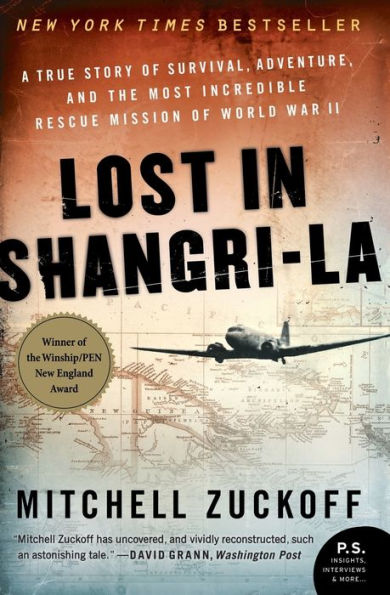Read an Excerpt
Lost in Shangri-La
A True Story of Survival, Adventure, and the Most Incredible Rescue Mission of World War II
By Mitchell Zuckoff
HarperCollins
Copyright © 2011 Mitchell Zuckoff
All right reserved.
ISBN: 9780061988349
Chapter One
M I S S I N G
On a rainy day in May 1945, a Western Union messenger made
his rounds through the quiet village of Owego, in upstate New
York. Just outside downtown, he turned onto McMaster Street, a
row of modest, well-kept homes shaded by sturdy elm trees. He
slowed to a stop at a green, farm-style house with a small porch
and empty flower boxes. As he approached the door, the messenger
prepared for the hardest part of his job: delivering a telegram
from the U.S. War Department.
Directly before him, proudly displayed in a front window,
hung a small white banner with a red border and a blue star at its
center. Similar banners hung in windows all through the village,
each one to honor a young man, or in a few cases a young woman,
gone to war. American troops had been fighting in World War II
since 1941, and some blue-star banners had already been replaced
by banners with gold stars, signifying a loss for a larger gain and a
permanently empty place at a family's dinner table.
Inside the blue-star home where the messenger stood was
Patrick Hastings, a sixty-eight-year-old widower. With his wire rim
glasses, his neatly trimmed silver hair, and the serious set of his
mouth, Patrick Hastings bore a striking resemblance to the new
president, Harry S. Truman, who'd taken office a month earlier
upon the death of Franklin Delano Roosevelt.
A son of Irish immigrants, Patrick Hastings grew up a farm
boy across the border in Pennsylvania. After a long engagement,
he married his sweetheart, schoolteacher Julia Hickey, and they'd
moved to Owego to find work and raise a family. As the years
passed, Patrick rose through the maintenance department at a
local factory owned by the Endicott-Johnson Shoe Company, which
churned out combat boots and officers' dress shoes for the U.S.
Army. Together with Julia, he reared three bright, lively daughters.
Now, though, Patrick Hastings lived alone. Six years earlier, a
fatal infection had struck Julia's heart. Their home's barren flower
boxes were visible signs of her absence and his solitary life.
Their two younger daughters, Catherine and Rita, had
married and moved away. Blue-star banners hung in their homes, too,
each one for a husband in the service. But the blue-star banner in
Patrick Hastings's window wasn't for either of his sons-in-law. It
honored his strong-willed eldest
daughter, Corporal Margaret
Hastings of the Women's Army
Corps, the WACs.
Sixteen months earlier, in
January 1944, Margaret Hastings
had walked into a recruiting
station in the nearby city of
Binghamton. There, she signed
her name and took her place
among the first generation of
women to serve in the U.S.
military. Margaret and thousands
of other WACs were dispatched
to war zones around the world,
mostly filling desk jobs on bases
well back from the front lines.
Still, her father worried, knowing
that Margaret was in a strange, faraway land: New Guinea,
an untamed island just north of Australia. Margaret was based
at a U.S. military compound on the island's eastern half, an area
known as Dutch New Guinea.
By the middle of 1945, the military had outsourced the delivery
of bad news, and its bearers had been busy: the combat death
toll among Americans neared 300,000. More than a 100,000 other
Americans had died noncombat deaths. More than 600,000 had
been wounded. Blue-star families had good reason to dread the
sight of a Western Union messenger approaching the door.
On this day, misery had company. As the messenger rang
Patrick Hastings's doorbell, Western Union couriers with nearly
identical telegrams were en route to twenty-three other star-banner
homes with loved ones in Dutch New Guinea. The messengers
fanned out across the country, to rural communities including
Shippenville, Pennsylvania; Trenton, Missouri; and Kelso,
Washington, and to urban centers including New York, Philadelphia,
and Los Angeles.
(Continues...)
Excerpted from Lost in Shangri-La by Mitchell Zuckoff Copyright © 2011 by Mitchell Zuckoff. Excerpted by permission of HarperCollins. All rights reserved. No part of this excerpt may be reproduced or reprinted without permission in writing from the publisher.
Excerpts are provided by Dial-A-Book Inc. solely for the personal use of visitors to this web site.




